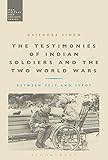The Testimonies of Indian Soldiers and the Two World Wars : Between Self and Sepoy / Gajendra Singh.
Material type: TextSeries: Publisher: London, England ; New York : Bloomsbury Academic, 2014Description: ix, 295 pages : illustrations ; 24 cmContent type:
TextSeries: Publisher: London, England ; New York : Bloomsbury Academic, 2014Description: ix, 295 pages : illustrations ; 24 cmContent type: - text
- unmediated
- volume
- 9781780936277 (hardback)
- 9781472583895 (hardback)
- India. Army -- History -- 20th century
- Great Britain. Army. British Indian Army -- History -- 20th century
- India -- History, Military -- 20th century
- World War, 1914-1918 -- Participation, Indian
- World War, 1939-1945 -- Participation, Indian
- Great Britain. Army. British Indian Army
- India. Army
- World War (1914-1918)
- World War (1939-1945)
- Military participation -- Indian
- India
- 1900 - 1999
- Kolonialismus
- Selbstbild
- Soldat
- Indien
- 355.009540904 23
| Item type | Current library | Call number | Copy number | Status | Date due | Barcode | Item holds | |
|---|---|---|---|---|---|---|---|---|
 Books
Books
|
Library, Independent University, Bangladesh (IUB) South Asian Corner (Level 4) | 355.009540904 S6173t 2014 (Browse shelf(Opens below)) | 01 | Not For Loan | 024425 |
Includes bibliographical references (pages 266-286) and index.
Introduction -- Insearch of colonial negatives: martial race theories, recruiting handbooks and the indian army, c. 1890-1945 -- 'More like brothers and fathers to the sepoys': welfare, dscipline and censorship in the army -- The perils of "Oriental Correspondence': Sepahis, letters and writing at the crossroads -- Throwing snowballs in France: (Re- ) Writing a letter and (Re- ) Appriasing Islam, 1915-1918 -- Mutiny, fabricating court testimony and hiding in the latrine: the 5th infantry in Singapore -- 'Breaking the Chains with Which We Were Bound': the interrogation chamber, the Indian National Army and the Negation of Military Identities, 1941-1947 -- Conclusioin: Reading Rebels, Writing Ghosts.
In the two World Wars, hundreds of thousands of Indian sepoys were mobilized, recruited and shipped overseas to fight for the British Crown. The Indian Army was the chief Imperial reserve for an empire under threat. But how did those sepoys understand and explain their own war experiences and indeed themselves through that experience? How much did their testimonies realise and reflect their own fragmented identities as both colonial subjects and imperial policemen? The Testimonies of Indian Soldiers and the Two World Wars draws upon the accounts of Indian combatants to explore how they came to terms with the conflicts. In thematic chapters, Gajendra Singh traces the evolution of military identities under the British Raj and considers how those identities became embattled in the praxis of soldiers{u2019} war testimonies {u2013} chiefly letters, depositions and interrogations. It becomes a story of mutiny and obedience; of horror, loss and silence. This book tells that story and is an important contribution to histories of the British Empire, South Asia and the two World Wars --Provided by publisher.
